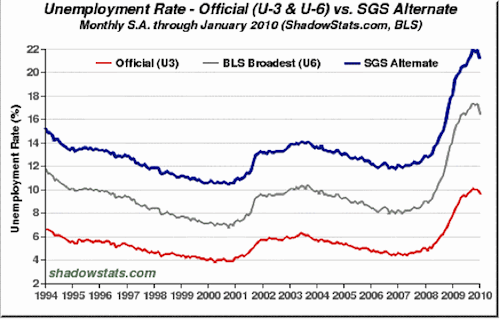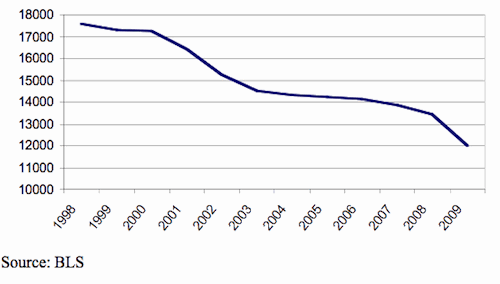High levels of unemployment may last indefinitely. A number of economists (including this writer) have been warning about permanent joblessness, and the idea is now seeping into popular magazines .
More than 8 million American jobs were lost since 2007, based on the most recent revision of the overall job count of U.S. establishments. But that is not the worst of it, because the establishment survey fails to capture smaller businesses and the self-employed. By the Bureau of Labor Statistics’ broadest measure of unemployment, including the forced part-time workers and so-called discouraged workers, the unemployment rate rose to 17 percent from 8 percent before the recession. That is 9 percentage points, corresponding to slightly over 12 million adults. A website called Shadow Government Statistics includes “long-term discouraged” workers defined out of the labor force by the BLS, but that alternative measure has tracked the BLS broad measure quite closely in the past few years.

There are several reasons to believe that most of these jobs never will come back. That is a less contentious statement than it might appear, because the jobs lost in the recessions since 1981 never came back. Some sectors, notably manufacturing, continued to shrink, and other sectors, such as heath care and retail, replaced them. The difference in 2010 is that it is not apparent where new jobs will come from.
There was no recovery in manufacturing jobs after the last recession, for instance. The total fell from 17.263 million in 2000 to 16.441 in 2001”and continued to fall every year through 2009.
Manufacturing Employment, 1998“2009 (1000’s)

At just 12 million, manufacturing employment is such a small portion of the 138 million employed Americans that any likely change would have a negligible impact on overall employment levels.
What replaced the lost manufacturing jobs? The sectors showing the largest increase in employment since 1993 (the end of the “employment recession” of the early 1990s) are shown in the table below, along with the change in employment since 2007:

The largest contributor to employment growth turns out to be professional services. This includes everything from real estate to accounting to law. We observe that construction gained about as many jobs (2.851 million) between 1993 and 2007 as manufacturing lost (2.895 million)”if off-the-books labor were counted, the number would be much higher. The “professional services” category was buoyed by the real-estate boom. That is why it lost almost as many jobs (1.155 million) as construction (1.396 million) after 2007.
In fact, of the sectors contributing most to employment growth during the long employment boom of 1993“2007, only education, health, and government (which partially overlap) sustained employment increases between 2007 and 2009. It is reasonable to expect that the aging U.S. population will require more health services going forward, but hiring is likely to be incremental at best. Government spending under the Obama stimulus plan helped postpone layoffs at the state and local level, but is unlikely to create many new jobs.
The construction boom is over for a generation or more. Residential housing is vastly overbuilt. As I wrote earlier this year :
In 1973, the United States had 36 million housing units with three or more bedrooms, not many more than the number of two-parent families with children”which means that the supply of family homes was roughly in line with the number of families. By 2005, the number of housing units with three or more bedrooms had doubled to 72 million, though America had the same number of two-parent families with children.
From other cross-sections of the data we see that the job losses have hit hardest the blue-collar working class, but also they’ve hit the upwardly mobile with some college training:

Workers with a B.A. degree or greater show a relatively low unemployment rate, although these numbers do not take into account long-term unemployed.
Given the inability of manufacturing industry to absorb many workers, and the poor likelihood that construction will do so, it is not clear where, or if ever, a large part of the American blue-collar labor force will work again. The semi-trained white collar labor force with an associate degree or a couple of years of college found ready work in the services expansion associated with the real-estate boom, but it is not clear what will happen to them now.
In previous recoveries, virtually all net new job creation came from new businesses. Most new businesses, to be sure, are small businesses, although the ones that created the most jobs were startups that grew very quickly. The most common estimate is that new business accounts for about two-thirds of net job creation.
During the 1980s, cellular phones, cable television, and other new technologies were an important source of new job growth. During the 1990s, the tech boom funded tens of thousands of startups, and, during the 2000s, the real-estate boom. Every deadbeat could get a job in the 1980s installing cable televisions, and every starving artist became a real-estate agent during the 2000s.
For the past fifteen years, the American economy has been geared to invest inflows of foreign capital in the household balance sheet, using the proceeds to import goods from the countries who lent us the money. That came to a bad end in 2007. All the employment associated with investing foreign savings and spending the proceeds”real-estate sales, mortgage banking, retail trade, and so forth”is no longer required. With a rapidly aging population, America will see less residential investment and more savings. America should be investing in high-value-added manufacturing and exporting. That would help America’s balance sheet, but it won’t do much for aging, semi-skilled workers who are too old to learn a completely new trade. Nor, as noted, will manufacturing in the best of cases create many new jobs.
There is some analogy to the Great Depression in the present situation. Between 1918 and 1939, American agriculture was in permanent decline, because the end of the First World War reduced demand for American exports, and because the substitution of the tractor for draught animals freed up an enormous amount of land set aside for animal feed. There was nothing to be done but to get the farmers off the land into other occupations, and that was not accomplished until the Second World War.
Americans, in short, have grown old in bad habits, and there is no way to avoid substantial and prolonged pain. The proposals that Reuven Brenner and I have offered in recent issues of First Things ”a shift in the tax system to place the burden on consumption while exempting investment income”will help in the medium term, but certainly will not help some labor-intensive service industries (e.g., gaming) in the short run.
The temptation will be to emulate Britain after World War II, that is, to have the government provide jobs. If we do that, we will end up looking like Britain: permanently unemployed and permanently economically irrelevant. The difficulty is that no economic policy can prevent a very painful adjustment.
David P. Goldman is senior editor of First Things
You have a decision to make: double or nothing.
For this week only, a generous supporter has offered to fully match all new and increased donations to First Things up to $60,000.
In other words, your gift of $50 unlocks $100 for First Things, your gift of $100 unlocks $200, and so on, up to a total of $120,000. But if you don’t give, nothing.
So what will it be, dear reader: double, or nothing?
Make your year-end gift go twice as far for First Things by giving now.


